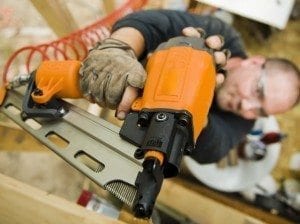
Causes of nail gun injuries
The Occupational Safety and Health Administration (OSHA) has identified seven major risk factors that commonly lead to nail gun injuries. Understanding how they happen and how to prevent them will help you use a nail gun safely and stay injury-free.

If you are using the nail gun for toe nailing or must nail while in an awkward position, push the contact safety tip into the work piece first and then squeeze the trigger. This makes careful nail placement easier and minimizes the risk of ricochet or blow-out.
Double fire
This occurs with a contact trigger. A second unintended firing can happen faster than the user is able to react and release the trigger. This is common when trying to accurately place the contact safety tip against a work piece, pushing hard on the tool to compensate for recoil, or working in an awkward position in which the nail gun doesn’t have enough space to recoil (between wall studs, for example).
Accidentally knocking the nosepiece with the trigger squeezed
This occurs with both contact and single actuation triggers. It may feel natural to carry a nail gun around with a four-finger grip on the handle and your finger on the trigger, but that’s an easy way to invite injury. Think of how easy it would be to bump your leg with the contact safety piece while climbing down a ladder or running into a co-worker coming around a corner; if the trigger is squeezed, nail gun injuries are the result.
Nail ricochet
Similar to a blow-out nail except the nail doesn’t penetrate the surface but bounces off and either strikes the worker’s hand or becomes a projectile. Ricochets are especially likely when nailing into dense hardwoods and laminated beams, or when nailing around metal framing hardware.
Missing the work piece
When the tip of the nail gun doesn’t make full contact with the work piece, the discharged nail can become a projectile. This type of nail gun injuries is common when nailing near the edge of a work piece, such as a top wall plate, and is a regular occurrence when nailing through plywood or OSB and missing the stud beneath (the nail completely penetrates through the sheet good and becomes a projectile on the other side).
Nailing in an awkward position
This occurs with all trigger types, but is of particular concern with contact and single actuation triggers. When you are working in an awkward position, the tool and recoil are harder to control, increasing the chances of nail gun injuries. This is common with toe-nailing, nailing above shoulder height, nailing in tight quarters, using your non-dominant hand or nailing toward yourself.
Bypassing safety mechanisms
You may think you’re making things quicker or easier by disabling certain features of the trigger or safety contact tip, or sometimes a safety feature can become worn and no longer function properly – but, both can lead to nail gun injuries.
How to use a nail gun
- Know your nail gun.
- Never allow anything to touch or bump the nail gun trigger until you are ready to fire.
- Never fire a nail gun while it’s pointed at any part of your body. If you must hold on to the work piece while nailing, keep your hand at least 12 inches away from the nail gun.
- Before you pull the trigger, be sure you know what’s on the other side of what you’re nailing.
- Wear personal protective equipment when using nail guns.
- Disconnect the nail gun’s air supply when loading, unloading or clearing a jammed nail.
- Consider limiting new employees and those with little construction experience to nail guns that have a full sequential trigger until you can fully evaluate their proficiency with the tool.

